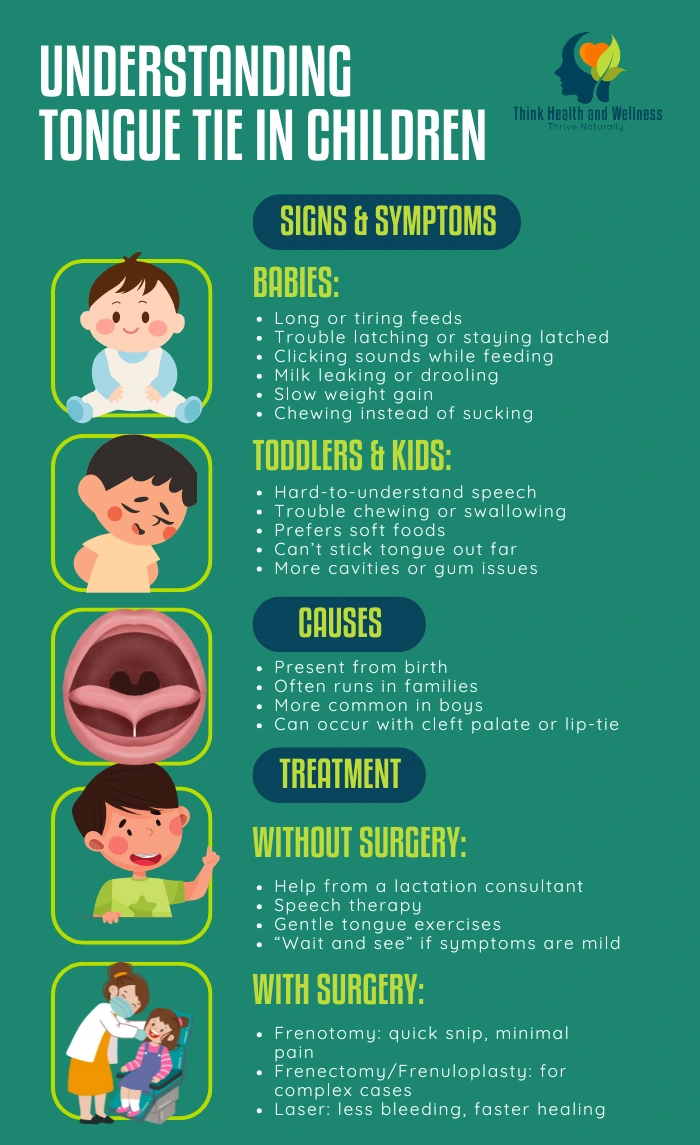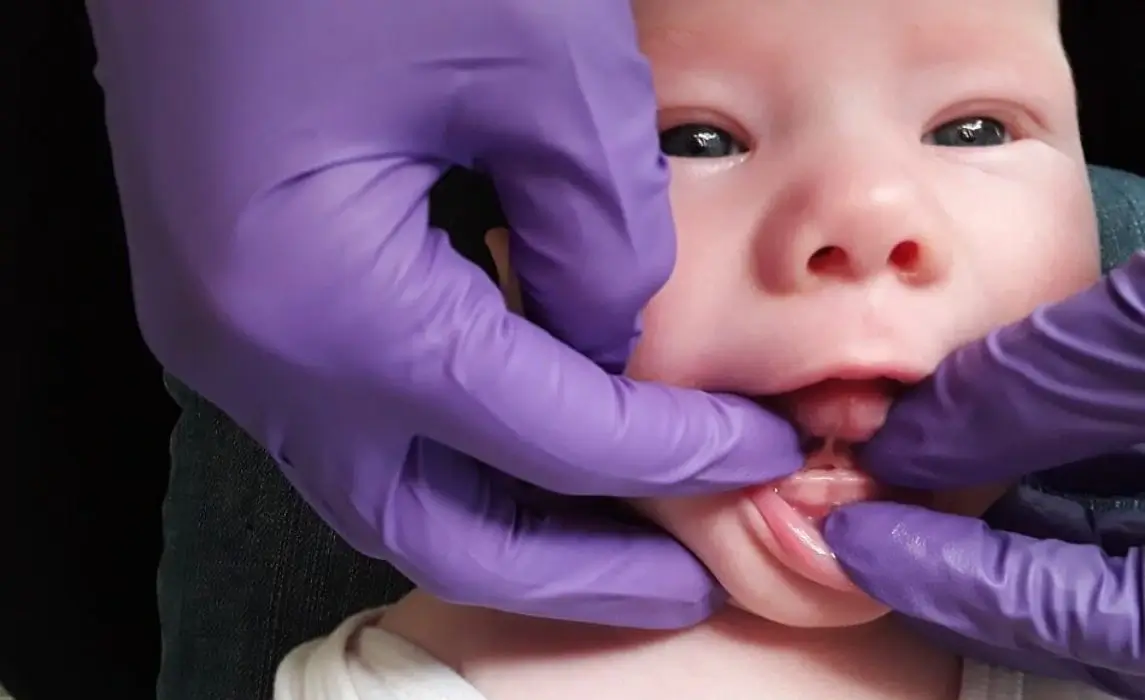Tongue-Tie (Ankyloglossia): Signs Your Baby Needs Help

Yes—finger plays, clapping games, and dance routines that use hand gestures all help. Combine rhythm and repetition for deeper learning.
Send home simple activity ideas, kits, or worksheets. Offer short instructions and encourage family involvement. Regular practice builds lasting progress.
Try origami, sticker scenes, stringing pasta, or painting with Q-tips. Crafts that use small pieces build precision and control.

When your baby struggles to latch during breastfeeding, or your preschooler's speech seems unusually unclear despite months of practice, it's natural to feel concerned. While many parents attribute these challenges to "picky eating" or assume their child is simply a "late talker," there's sometimes a hidden physical reason behind the struggle: tongue-tie.
What Is Tongue-Tie and Why It Matters

Tongue-tie, medically known as ankyloglossia, is a condition where the lingual frenulum (the small band of tissue connecting the underside of the tongue to the floor of the mouth) is too short, too tight, or attached too close to the tongue's tip. In typical anatomy, this tissue allows the tongue to move freely in all directions. When it's restricted, the tongue cannot reach its full range of motion.
This restriction matters more than you might think. The tongue plays a crucial role in:
- Feeding: Babies need a full range of tongue movement to create proper suction and efficiently extract milk during breastfeeding or bottle-feeding
- Speech development: Clear pronunciation of many sounds requires the tongue to reach specific positions in the mouth
- Oral hygiene: A mobile tongue helps clean food particles from teeth and gums
- Oral development: Tongue movement influences the shape and spacing of teeth as they grow
Tongue-Tie Symptoms and Signs
In Infants (0-12 months)
Feeding difficulties are often the first clue:
- Prolonged feeding sessions (over 40 minutes) with frequent breaks
- Poor latch during breastfeeding, often slipping off the breast
- Clicking sounds while feeding, indicating lost suction
- Excessive drooling or milk leaking from the mouth during feeds
- Inadequate weight gain or failure to thrive
- Gumming or chewing the nipple instead of proper sucking
- Apparent hunger shortly after lengthy feeding sessions
For breastfeeding mothers, tongue-tie in the infant can cause:
- Severely cracked, blistered, or bleeding nipples
- Misshapen nipple after nursing (compressed or lipstick-shaped)
- Persistent pain during and after feedings
- Mastitis or plugged milk ducts from inefficient milk removal
In Toddlers and Older Children
As children grow, different symptoms become apparent:
Speech challenges:
- Difficulty pronouncing sounds that require tongue elevation (t, d, z, s, th, n, l)
- Unclear speech that's hard for others to understand
- Frustration when trying to communicate
Eating difficulties:
- Trouble moving food around in the mouth
- Difficulty chewing solid foods thoroughly
- Preference for soft or pureed foods beyond the expected age
- Food pocketing in the cheeks
- Messy eating due to limited tongue control
Physical signs:
- Inability to stick the tongue out past the lower lip
- Tongue tip appears notched or heart-shaped when extended
- Tongue tip cannot touch the roof of the mouth
- Difficulty licking an ice cream cone or lollipop
- Limited side-to-side tongue movement
Oral health issues:
- Increased cavities, especially on lower front teeth
- Gum irritation or recession
- Gap between lower front teeth
Other concerns:
- Mouth breathing
- Snoring or sleep disturbances
- Challenges with certain wind instruments in music class
Causes and Risk Factors of Tongue Tie (Ankyloglossia)
Tongue-tie is a congenital condition, meaning it's present at birth. The exact cause isn't fully understood, but several factors are believed to play a role:
Genetic factors: Tongue-tie tends to run in families. If a parent had tongue-tie, there's an increased likelihood their children might have it too.
Developmental factors: During pregnancy, the lingual frenulum normally separates to allow proper tongue mobility. In tongue-tie, this process doesn't complete normally, leaving too much tissue attached.
Associated conditions: While tongue-tie can occur on its own, it's sometimes seen alongside other conditions such as:
- Cleft palate or other craniofacial differences
- Certain genetic syndromes affecting connective tissue
Risk factors:
- Male sex (boys are 2-3 times more likely to have tongue-tie)
- Family history of tongue-tie or other oral restrictions
- Sometimes occurs with lip-tie (restricted upper lip frenulum)
It's important to note that nothing the mother did or didn't do during pregnancy causes tongue-tie, it's simply a variation in how the baby developed.
Possible Complications if Untreated
Not all cases of tongue-tie need treatment, but leaving a significant one unaddressed can lead to issues in several areas:
- Feeding: Poor nutrition, early weaning, bottle refusal, or delayed transition to solids
- Speech: Ongoing articulation problems, social anxiety, unclear speech, and academic challenges
- Oral health: Higher risk of tooth decay, gum disease, and orthodontic issues
- Daily life: Difficulty licking lips or kissing, limited food choices, jaw tension, and TMJ problems
- Social and emotional: Frustration, behavioral concerns, and avoidance of speaking or social situations
The good news is that with timely identification and appropriate treatment, most of these complications can be prevented or minimized.
Diagnosis
Tongue-tie is diagnosed through observation and a physical exam by professionals such as pediatricians, pediatric dentists, ENTs, lactation consultants, speech-language pathologists, or oral surgeons.
How diagnosis is done:
- History: Discuss feeding issues, speech development, and family background.
- Visual check: Examine the frenulum for thickness, tightness, and attachment.
- Function test: Assess tongue movement — extension, elevation, side-to-side motion, and shape (heart or V-shape may indicate restriction).
- Feeding or speech observation: For infants, evaluate latch and sucking during feeding; for older children, check articulation and clarity.
- Assessment tools: Some providers use tools like Hazelbaker Assessment Tool for Lingual Frenulum Function (HATLFF) or the Bristol Tongue Assessment Tool (BTAT) to objectively measure the degree of restriction and functional impact.
Note: A visible frenulum alone doesn’t mean treatment is necessary. What matters is whether it causes functional problems. Some children have a noticeable frenulum but no difficulties whatsoever.
Treatment Options
Not all cases of tongue-tie need treatment. Options depend on the child’s age, symptoms, and family preferences.

Conservative Management
For mild cases or those who prefer non-surgical approaches:
- Lactation support: Working with an IBCLC can improve positioning, latch, and feeding techniques.
- Speech therapy: Older children may benefit from articulation exercises and strategies.
- Oral motor exercises: Gentle tongue stretches may help, but should only be done under professional guidance.
- Watchful waiting: If symptoms are minimal and not affecting nutrition, speech, or quality of life, regular monitoring is an option.
Surgical Treatments
If conservative care isn’t enough, releasing the frenulum may be recommended:
- Frenotomy: A quick, simple snip of the frenulum. Usually done in-office, often without anesthesia for newborns, with immediate feeding improvement and minimal discomfort.
- Frenectomy/Frenuloplasty: A more involved procedure for thicker or complex ties, possibly requiring stitches and longer healing.
- Laser Frenectomy: Uses a laser for less bleeding, lower infection risk, and faster healing, though it may cost more and isn’t available everywhere.
Post-Procedure Care
- Gentle stretching exercises for several weeks to prevent reattachment
- Pain relief if needed
- Feeding is usually encouraged immediately after the procedure
- Follow-up visits to check healing and function
You May Also Like: Toddler Hitting and Biting: Is Aggressive Behavior Normal for Toddlers?
Red Flags vs. Normal Variation
It's natural to worry when you notice something different about your child's anatomy or development. Understanding what's concerning versus what's normal variation can help you respond appropriately.
Seek prompt assessment if you observe:
- Newborn unable to transfer adequate milk during feedings
- Weight loss exceeding 10% of birth weight or failure to regain birth weight by two weeks
- Severely painful breastfeeding that doesn't improve with position changes
- Infant always seems hungry despite frequent, lengthy feedings
- By age 3, child's speech is largely unintelligible to unfamiliar listeners
- Child gagging or struggling with age-appropriate solid foods beyond developmental readiness period
- Visible distress or frustration when trying to eat or speak
- Tongue cannot extend past the lower lip or touch the roof of the mouth
- Heart-shaped tongue tip when extended
- Dental or oral health problems potentially related to tongue restriction
Don't panic if:
- You can see a frenulum under the tongue. Everyone has one; visibility alone isn't a problem
- Your newborn has some initial feeding challenges in the first few days. Many babies take time to master feeding regardless of tongue tie
- Your toddler's speech isn't perfectly clear. Articulation typically continues developing until age 7-8
- Your child seems to have a "short" tongue but feeds well, speaks clearly, and has no functional limitations
- Feeding improves after working with a lactation consultant without any procedure
You May Also Like: Is There a Cure for Rabies? Understanding the Facts About Treatment and Potential Cure for Rabies
Conclusion
Tongue-tie is more common than most people think, and its effects can range from barely noticeable to more challenging. The key is knowing when a tight frenulum is actually causing problems with feeding, speech, oral health, or daily life and when it’s just a harmless difference.
If you suspect your child might have tongue-tie, trust your gut and talk to a qualified healthcare provider. Catching it early makes it easier to step in when needed, often preventing complications and helping your child grow and develop smoothly. And even if treatment is necessary, the outlook is usually excellent. Most kids go on to feed well, speak clearly, and enjoy a full variety of foods.
For children who don’t need surgery, the right support from parents and educators can still make a huge difference. Every child’s journey is unique, and what matters most is that they get the understanding, care, and encouragement they need to thrive. Whether you’re helping a newborn with feeding, guiding a preschooler’s speech, or supporting a student in the classroom, knowing about tongue-tie helps you spot concerns early and offer the right support every step of the way.
You May Also Like: Personal Hygiene for Kids: 10 Simple Habits for a Healthy, Confident Child




